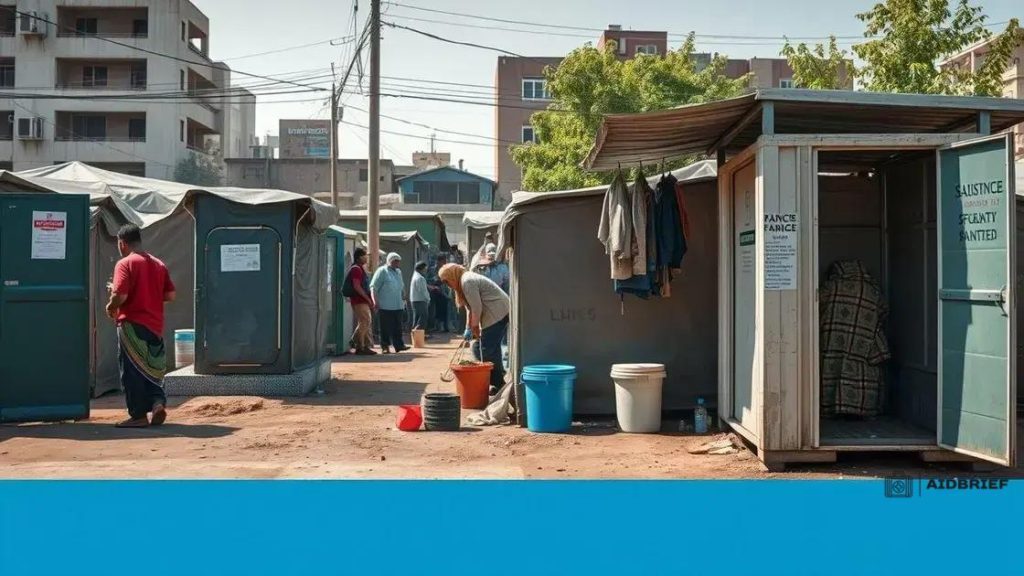Innovative sanitation solutions in urban refugee camps

Innovative sanitation solutions in urban refugee camps focus on advanced technologies, community engagement, and sustainable practices to effectively improve health and hygiene conditions for displaced populations.
Innovative sanitation solutions in urban refugee camps are critical to improving health and well-being for displaced populations. Have you ever wondered how these initiatives can transform lives? Let’s dive into the current approaches and their impacts.
Overview of sanitation challenges in urban refugee camps
Sanitation in urban refugee camps presents numerous challenges that significantly affect health and quality of life. Many refugees face inadequate facilities and harsh living conditions that hinder their ability to maintain personal hygiene. The lack of clean water and proper waste disposal methods intensifies these issues.
Key challenges to sanitation
Among the various factors influencing sanitation, several stand out as particularly pressing. For instance, overcrowding makes it difficult to provide sufficient sanitation facilities. Additionally, the transient nature of refugee camps can lead to a lack of infrastructure investment, resulting in poor hygiene.
- Inadequate access to clean water supplies
- Poor waste management practices
- Overcrowding and lack of space for sanitation facilities
- Lack of community involvement in sanitation efforts
Moreover, cultural differences and a lack of awareness can complicate efforts to implement effective sanitation solutions. Education and community engagement are crucial in addressing these challenges. By informing refugees about hygiene practices and involving them in sanitation projects, we can foster a sense of ownership and responsibility.
The impact of sanitation on health
Innovative sanitation solutions are essential to improve health outcomes for refugees. Poor sanitation can lead to outbreaks of diseases such as cholera and dysentery, which spread rapidly in crowded living conditions. Ensuring access to clean facilities can help reduce the incidences of these illnesses and improve overall health.
To combat these challenges, organizations are looking for ways to enhance sanitation services. By employing technologies that prioritize sustainability and community participation, we can create a healthier environment for displaced individuals. Investing in sanitation not only addresses immediate needs but also lays the groundwork for future development.
Innovative technologies improving sanitation
Innovative technologies are playing a vital role in enhancing sanitation in urban refugee camps. By implementing creative solutions, organizations can significantly improve hygiene and health for those living in challenging environments.
Types of innovative technologies
Several cutting-edge technologies are helping to address sanitation issues. These solutions not only make facilities more efficient but also promote sustainability. Some examples include:
- Mobile toilets: Easily transportable and self-contained, these units help manage waste effectively, especially in overcrowded settings.
- Water purification systems: These systems make it easier to access clean water through filtration and treatment, reducing the risk of water-borne diseases.
- Solar-powered sanitation solutions: Utilizing renewable energy, these facilities can operate efficiently even in remote areas.
- Biodegradable waste management: Innovative designs allow for the breakdown of waste using natural processes, making waste disposal more environmentally friendly.
Furthermore, technology can facilitate community engagement in hygiene practices. For instance, mobile apps provided by NGOs can help educate refugees about proper sanitation methods. By raising awareness, it encourages better health practices.
The role of innovation in community engagement
Incorporating technology into sanitation efforts fosters community participation. When individuals feel included in the planning and implementation of sanitation solutions, they are more likely to take care of the facilities. Participatory designs that cater to cultural needs can enhance acceptance and usage. This, in turn, leads to better management of sanitation resources.
Additionally, collecting data using technology can help tailor solutions for specific community needs. By understanding the unique challenges faced by refugees, organizations can deploy more effective strategies, ensuring that sanitation services are beneficial and impactful.
Community engagement in sanitation programs

Community engagement is essential for the success of sanitation programs in urban refugee camps. When individuals participate in these initiatives, outcomes improve significantly. By involving the community, we can ensure that sanitation solutions are effective and sustainable.
The importance of involvement
Engaging the community not only fosters a sense of ownership but also enhances awareness about hygiene practices. When people understand the benefits of sanitation, they are more likely to use available facilities properly. This leads to a healthier living environment.
- Feedback mechanisms: Gathering input from community members helps tailor solutions to meet specific needs.
- Training programs: Educational initiatives can empower individuals with knowledge about hygiene and proper sanitation practices.
- Volunteer efforts: Encouraging community members to participate in sanitation activities promotes solidarity and shared responsibility.
- Cultural sensitivity: Understanding the diverse backgrounds of refugees ensures that programs are respectful and relevant.
When communities are actively involved, they can help identify the challenges they face. This leads to innovative ideas and solutions that local organizations may not consider. Participants may also share their knowledge about traditional practices that contribute to better hygiene.
Implementing successful strategies
Organizations should adopt strategies that encourage participation, such as community meetings or workshops. These platforms allow individuals to voice their concerns and suggest improvements. Furthermore, recognizing and celebrating community-led initiatives can boost morale and motivation.
Involving women and children in sanitation programs is especially crucial, as they often manage family hygiene. By empowering these groups, we create a ripple effect that benefits the entire camp. Overall, engaging the community ensures that sanitation programs are not just temporary fixes but sustainable initiatives that enhance the quality of life.
Case studies of successful implementations
Examining case studies of successful sanitation implementations in urban refugee camps provides valuable insights into effective strategies. These examples showcase how innovative practices can make a positive impact on hygiene and health.
Case Study 1: Innovative Waste Management in Kenya
In one urban refugee camp in Kenya, a local NGO implemented a waste management program that involved community members. They provided training on how to sort waste and recycle materials. This initiative not only reduced waste but also created jobs for residents. Through community involvement, the camp saw a significant improvement in sanitation.
Case Study 2: Water Purification Systems in Jordan
Another successful case occurred in a Jordanian camp where water purification systems were installed. These units ensured access to clean drinking water, drastically reducing water-borne illnesses. Community training sessions taught families how to maintain and use these systems effectively. This empowerment led to safer drinking water and improved health outcomes.
Key elements of success
Successful implementations often share common elements. These include:
- Community engagement: Involving residents in planning and decision-making fosters ownership.
- Education and training: Teaching hygiene practices and maintenance of facilities boosts awareness.
- Partnerships: Collaborating with local organizations enhances resources and knowledge.
- Adaptability: Solutions that consider cultural and environmental factors are more likely to succeed.
While these case studies highlight successes, they also provide lessons for future projects. By understanding what worked well, organizations can replicate these strategies in other settings. Overall, real-world examples guide the development of effective sanitation solutions that respond to the specific needs of urban refugee populations.
Future outlook for sanitation in refugee contexts
The future of sanitation in refugee contexts holds promise as innovative solutions continue to evolve. As more organizations recognize the importance of sanitation, we can expect enhancements that improve health and well-being among displaced populations.
Technological advancements
Emerging technologies are paving the way for new sanitation solutions. For instance, mobile applications can facilitate easier access to sanitation facilities and promote hygiene education. Furthermore, new biodegradable materials for waste management may offer sustainable alternatives.
Integrated approaches
Future programs are likely to adopt more integrated approaches that combine sanitation with other critical services, like health care and education. This holistic method addresses multiple needs simultaneously, leading to better overall outcomes.
- Community participation: Increasing involvement of refugees in program design will ensure solutions are appropriate and respected.
- Climate resilience: Future sanitation systems must also consider climate change impacts, adapting to extreme weather and resource scarcity.
- Data-driven decision-making: Collecting and analyzing data on sanitation practices can lead to improvements tailored to specific community needs.
- Sustainability focus: Emphasizing sustainable practices will help conserve resources and protect the environment.
Moreover, partnerships between governments, NGOs, and the private sector will enhance the resources and knowledge available for sanitation initiatives. As these collaborations grow stronger, they can drive innovative solutions and support capacity-building efforts within communities.
Ultimately, a forward-looking approach to sanitation in refugee contexts prioritizes not only immediate needs but also long-term sustainability and health. By focusing on comprehensive, community-centered solutions, we can create a healthier environment for displaced individuals.
FAQ – Frequently Asked Questions about Sanitation Solutions in Refugee Camps
Why is sanitation important in urban refugee camps?
Sanitation is crucial in urban refugee camps because it reduces the spread of diseases, improves health outcomes, and enhances the overall quality of life for residents.
What innovative technologies are being used to improve sanitation?
Innovative technologies such as portable toilets, water purification systems, and solar-powered facilities are being implemented to enhance sanitation in refugee contexts.
How can communities get involved in sanitation programs?
Communities can participate by providing feedback, attending training sessions, and volunteering in sanitation activities, which fosters ownership and responsibility for hygiene practices.
What are the future prospects for sanitation in refugee camps?
The future of sanitation in refugee camps includes a focus on sustainable practices, community engagement, and the integration of advanced technologies to create resilient systems.





